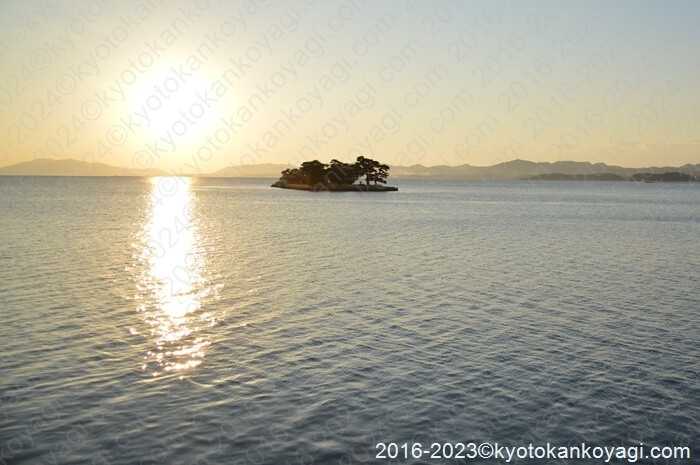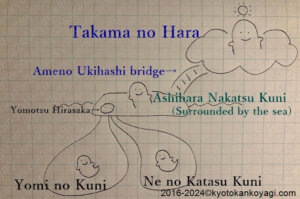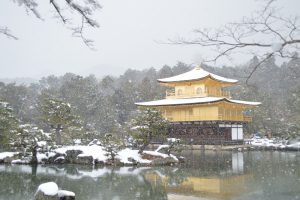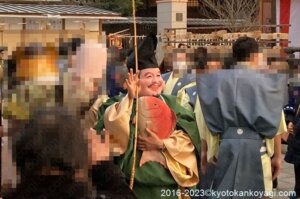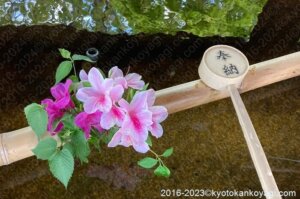Introduction
To understand Japanese culture and its inheritance without the knowledge of Japanese mythology. I’ll write a series of 5 posts on the important myths. In this post let us see the birth of Japan. 合掌
Kojiki and Nihon Shoki
Japanese mythology is described in The Kojiki (『古事記』An Account of Ancient Matters) and The Nihon Shoki (『日本書紀』The Chronicles of Japan). Under the development of the national consciousness, both of them were compiled in order to announce the legitimacy of the Imperial Court. They are ones of the most important source of Japanese mythology and theology.
These books are compiled to legitimize the rule of the Imperial court. Some story imply what actually happened, especially the process of expanding its territory and rule.
The universe of our mythology is like this.
- The place we live in is Ashihara Nakatsu Kuni where Kunitsu Kami (Kami belong to Ashiranra Nakatsukuni) and us are in.
- Up above it, there is Takama no Hara where Amatsu Kami (Kami belong to Takama no Hara.
- And under Ashihara Nakatsu Kuni, there are Yomi no Kuni and Ne no Katasu Kuni.
- There is Ameno Ukihashi bridge between Takamano Hara and Ashihara Nakatsu Kuni connected Yomi no Kuni and Ne no Katasu Kuni by a place called Yomotsu Hirasaka.
The birth of Japan
In the beginning, the center of the universe was floating around. It was divided into Ten, the place located up above the world, and Chi, the ground. They are linked with a bridge called Ame no Ukihashi (天の浮橋).
The Kami in Takama no Hara (高天の原), a.k.a., Ten asked Izanaki (伊邪那岐) and Izanami (伊邪那美) to prepare Chi. They stuck a spear called Ameno Nuboko into the ocean. When they pull out the spear, the dewdrops made Onogoro Jima island. The island grew up to Ashihara Nakatsu Kuni (葦原中国), the archipelago we live in.

Takama no Hara and Ashihara Nakatsu Kuni are not separated. There is Ame no Ukihashi bridge between them.

The island in front of Kinkakuji stands for Ashihra Nakatsu Kuni, i.e., Japan.
On the island, they married and had a child Kami named Hiruko. They put him on a boat and let the ocean brought him away because his body was “soft.”

Don’t worry. A fisherman saved his life. Some years later, Hiruko came back to us as Ebisuten, the Buddhist deity. We call him Ebessan in Kansai dialect.

Izanaki and Izanami had many children (Of course they are Kami). When Izanami gave birth to Kami of fire, she passed away with the fire of her child.
He missed her wife so much and he visited Yomi no Kuni, the place of the deceased. He found her and asked her to come back to the place she once belonged to. She replied that she would see Kami of Yomi no Kuni to make sure whether she could come back there. Closing the door, she said to Izanaki not to open the door.
He couldn’t afford to wait and open the door to find her corpse covered with many maggots. She was ashamed of it and chase after him. He escaped narrowly and put a huge rock in front of the entrance of Yomi no Kuni.
He bathed in a stream to get rid of Kegare he saw in Yomi no Kuni.

Kegare means an anemic state of mind. The dead body could be the maximum anemic state of mind. His bathing is the beginning of Misogi. When we visit Shinto shrines or Buddhist temples, we can experience an abbreviated one. Check out the link below.

First, he washed his left eye and Amaterasu Ohmikami (天照大御神), the Kami of the sun, was born. Next, he washed his right eye and Tsukuyomi no Mikoto (月読命), the Kami of night, was born. In the end, he washed his nose and Take Haya Susanoh no Mikoto (建速須佐之男命) was born. He asked them to rule Takama no Hara, the country of the moon, and the ocean respectively.
Next post

Let us see the conflicts between Amaterasu and Take Haya Susanoh and Iwato Gakure, BAAH!!!


